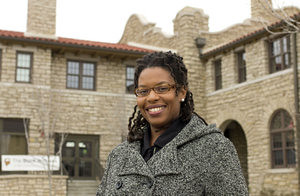
Not long ago, the Black Archives was locked up and closed in an old firehouse. Now new director Doretha Williams will help bring the collection back to life in its permanent home in the Historic 18th and Vine Jazz District., a photo by Pan-African News Wire File Photos on Flickr.
Posted on Mon, Jan. 02, 2012
After years of uncertainty, Black Archives has found its way
The collection, which had been at risk of deteriorating, is now safe in renovated quarters.
By BRIAN BURNES
The Kansas City Star
The Black Archives of Mid-America, a Kansas City heirloom once feared lost, is poised to re-emerge after years of uncertainty.
The archives’ one-of-a-kind collection, which tells the story of the region’s African-American community, had been considered at risk of deteriorating. But now the photographs, papers and artifacts are stored safely in renovated quarters, a former Kansas City Parks and Recreation maintenance building in the 18th and Vine district.
The archives has a new director, Doretha Williams, a Topeka native and holder of a doctorate in American Studies from the University of Kansas. A permanent exhibit is expected to open in June, in time for the annual Kansas City Juneteenth observances as well as the Major League Baseball All-Star Game events the following month.
None of this was obvious five years ago, when the archives’ holdings were locked away in its former firehouse headquarters at 2033 Vine St.
Revenue shortfalls had placed the holdings in peril, said Barbara Peterson, current head of the archives board of directors and widow of Horace Peterson, archives founder.
There were other issues. The archives for several years had neglected to pay property taxes, prompting Jackson County to sue. Failure to submit audits had caused the Kansas City Council to eliminate its subsidy, which at one point was $100,000 a year. Failure to file annual reports with the state caused the Missouri Secretary of State’s office to dissolve the archives as a nonprofit corporation.
By 2006, the building was closed.
State archivists who inspected the holdings declared some threatened by mold and mildew. At least one demonstration was held outside its door in an effort to raise awareness of the irreplaceable artifacts and documents in danger.
Ultimately, Jay Nixon, then the Missouri attorney general, intervened, helping to lead a dialogue aimed at seating a new board and agreeing on a new direction for the collection.
All that is over. A recent tour of the new archives’ home revealed photographs and documents stored in acid-free boxes, lined up on shelves.
“The collection is now secure,” Williams said.
One man’s vision
It started as a one-man organization.
Horace Peterson began assembling its holdings in the early 1970s. By the early 1980s, Peterson was displaying his collection in the former firehouse. Visitors could examine holdings ranging from a vintage comic book biography of U.S. Supreme Court Justice Thurgood Marshall to a baseball cap on loan from John “Buck” O’Neil, former Kansas City Monarchs star.
After Peterson drowned in 1992, Barbara Peterson resolved to maintain her husband’s collection.
“There was a severe shortage of resources to continue operations,” said Barbara.
“Those kinds of problems tend to snowball in terms of trying to continue programming and doing what you need to maintain yourself as part of the cultural community.”
Over time, renewal efforts gained traction. Officials broke ground in December 2007 at the archives’ proposed new home in the parks department’s former Parade Park Maintenance Building at 1722 E. 17th Terrace.
In 2008, the Ewing Marion Kauffman Foundation awarded a $1 million grant to the Kansas City Public Library to support completion of the build-out and renovation of the archives’ new home. Most of the archives’ holdings, Peterson said, were moved to the new location in the summer of 2010.
Many helpers
The involvement of the Kansas City Public Library made sense, said R. Crosby Kemper III, library executive director and archives board member. The library long has considered the Kansas City African-American community a stakeholder, and the library’s John Ramos Collection represents its own African-American repository.
But others deserve kudos, Kemper said.
He credits Carol Coe and Sharon Sanders Brooks, former Kansas City Council members, for alerting Nixon to the archives’ issues. Nixon, Kemper added, could have regarded the archives’ plight as an opportunity to “make political hay,” but exhibited an authentic interest.
Brooks, also a former state representative, said she appealed to Nixon after her entreaties to local officials went largely unheeded. Nixon’s intervention was key, she added, if also deliberate.
“Great things cannot be accomplished quickly,” said Brooks, now an archives board member.
Kemper also credits Carl Schramm, Kauffman Foundation president and chief executive officer, for coming forward with the $1 million grant.
Other players, Kemper said, were Kansas City and the Parks and Recreation Department for committing to the approximately $5 million renovation of the former maintenance building.
Credit also should go to Barbara Peterson, Kemper said.
“She could have treated it as a personal thing, but she treated it as a civic responsibility and did a great job creating the board,” Kemper said.
Room to grow
The renovated archives building, listed on the National Register of Historic Places, testifies to the archives’ credibility in the community, Williams said. One issue routinely faced by the officers of archives and small historical societies is the availability of permanent, secure space.
“The new building means the Black Archives has overcome that,” said Williams.
Researchers should be able to examine the holdings by summer. The new permanent exhibit, planned by Eisterhold Associates of Kansas City, is scheduled to open June 16.
No comments:
Post a Comment